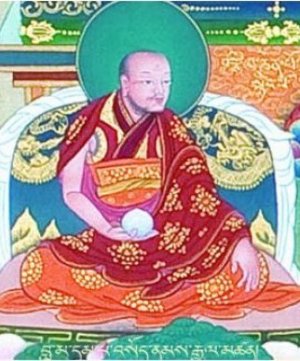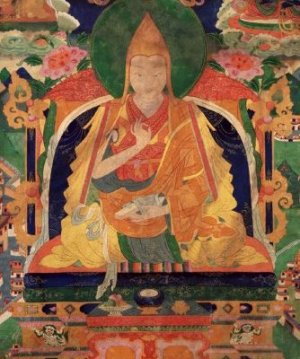| Library / Biographies |
Swami Śri Yukteśwar Giri Biography

Swami Śri Yukteśwar GiriŚri Yukteśwar Giri (also written Sriyuktesvara, Sri Yukteshwar) (10 May 1855 – 9 March 1936) was born Priya Nath Karar in Serampore, India to Kshetranath and Kadambini Karar.
Priya Nath lost his father at a young age and took on much of the responsibility for managing his family's land holdings.
A bright student, he passed the entrance exams and enrolled in Srirampur Christian Missionary College, where he developed an interest in the Bible. This interest would later express itself in his book, “The Holy Science,” which discusses the unity behind the principles underlying Yoga and the Bible.
He also attended Calcutta Medical College for almost two years. After leaving college, Priya Nath married and had a daughter. His wife died a few years after their marriage.
In 1884, Priya Nath met Lahiri Mahasaya, who became his Guru and initiated him into the path of Kriya Yoga, and received the name "Śri Yukteśwar Giri."
Śri Yukteśwar spent the next several years in the company of his guru, often visiting Lahiri Mahasaya in Benares.
In 1894, while attending the Kumbha Mela in Allahabad, he met the Guru of Lahiri Mahasaya, Mahavatar Babaji, who asked Śri Yukteśwar to write a book comparing Hindu scriptures and the Christian bible.
Mahavatar Babaji also bestowed on Śri Yukteśwar the title of 'Swami' at that meeting. Śri Yukteśwar completed the requested book in 1894, naming it Kaivalya Darsanam, or The Holy Science.
Śri Yukteśwar converted his large two-story family home in Serampore into an ashram, named "Priyadham", where he resided with students and disciples. In 1903, he also established an ashram in the seaside town of Puri, naming it "Karar Ashram".
From these two ashrams, Śri Yukteśwar taught students, and began an organization named "Sadhu Sabha".
An interest in education resulted in Śri Yukteśwar developing a syllabus for schools, about physics, physiology, geography, astronomy, and astrology. He also wrote a book for Bengalis on learning basic English and Hindi called First Book and wrote a basic book on astrology.
Later, he became interested in the education of women, which was uncommon in Bengal at that time.
Śri Yukteśwar was especially skilled in Jyotiṣa (Indian astrology) and prescribed various astrological gemstones and bangles to his students. He also studied astronomy and science, as evidenced in the formulation of his Yuga theory in The Holy Science.
In the introduction, he wrote: “The purpose of this book is to show as clearly as possible that there is an essential unity in all religions; that there is no difference in the truths inculcated by the various faiths; that there is but one method by which the world, both external and internal, has evolved; and that there is but one Goal admitted by all scriptures.”
He had only a few long-term disciples, but in 1910, the young Mukunda Lal Ghosh would become Sri Yukteswar's most well-known disciple, eventually spreading the teachings of Kriya Yoga throughout the world as Paramahansa Yogananda with his Self-Realization Fellowship/Yogoda Satsanga Society of India.
Yogananda attributed Sri Yukteswar's small number of disciples to his strict training methods, which Yogananda said "cannot be described as other than drastic".
Regarding the role of the Guru, Śri Yukteśwar said:
“Look, there is no point in blindly believing that after I touch you, you will be saved, or that a chariot from heaven will be waiting for you. Because of the guru's attainment, the sanctifying touch becomes a helper in the blossoming of Knowledge, and being respectful towards having acquired this blessing, you must yourself become a sage, and proceed on the path to elevate your Soul by applying the techniques of sadhana given by the guru.” (Satyananada Swami, Swami Sri Yukteshvar Giri Maharaj: A Biography)
Author W.Y. Evans-Wentz described his impression of Śri Yukteśwar in the preface to Yogananda's "Autobiography of a Yogi":
“Śri Yukteśwar was of gentle mien and voice, of pleasing presence, and worthy of the veneration, which his followers spontaneously accorded to him. Every person who knew him, whether of his own community or not, held him in the highest esteem. I vividly recall his tall, straight, ascetic figure, garbed in the saffron-colored garb of one who has renounced worldly quests, as he stood at the entrance of the hermitage to give me welcome. His hair was long and somewhat curly, and his face bearded. His body was muscularly firm, but slender and well-formed, and his step energetic.”
Śri Yukteśwar Giri attained mahāsamādhi1 at Karar Ashram, Puri, India on 9 March 1936.
Among his noted disciples were:
• Paramahansa Yogananda
• Swami Satyananda Giri
• Swami Hariharananda Giri
• Swami Bhabananda Giri
• Motilal Mukhopadyay
• Śri Sailendra Bejoy Dasgupta
• Śri Amulya Charan Santra
Sources
• Autobiography of a Yogi, Yogananda Paramahansa
• https://en.wikipedia.org/wiki/Swami_Sri_Yukteswar_Giri
Footnotes
1. In Hindu or Yogic traditions, Mahāsamādhi, the great and final samādhi, is the act of consciously and intentionally leaving one's body at the moment of death. According to this belief, a realized and enlightened (Jivanmukta), yogi (male) or yogini (female) who has attained the state of nirvikalpa samādhi (samādhi without seed), can consciously exit from their body and attain enlightenment, often while in a deep, conscious meditative state.





